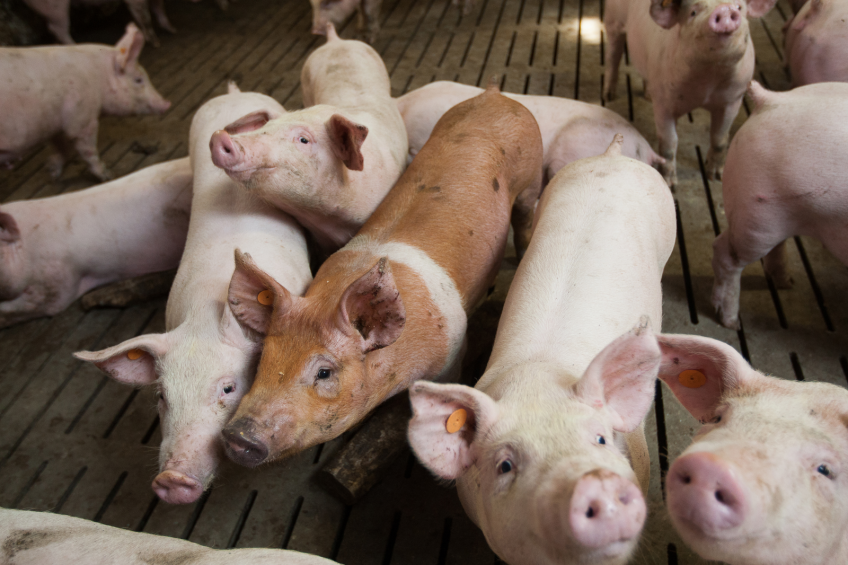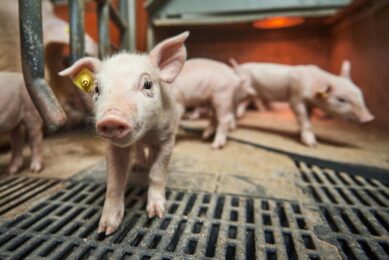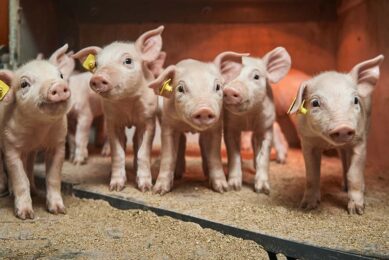PRRS costs money from start to finish

In breeding herds, the effects of Porcine Reproductive and Respiratory Syndrome (PRRS) may be more visible. The impact on grow-finish performance, however, is more costly.
PRRS has been called one of the world’s most expensive pig diseases, yet its actual economic impact on a breeding-finishing enterprise is often underestimated. When that happens, some vital decisions about whether and where to vaccinate could be based on a flawed assessment that under-values the financial benefit from vaccination relative to the cost of buying and applying the vaccine.
Multiple signs
At the heart of the problem is the complexity of signs and symptoms which can accompany an infection of the PRRS virus. The list of complicating factors begins with the stage of production affected. Since the reproductive effects in infected sows are generally much more visible and therefore more immediately obvious than the loss of performance in growing-finishing pigs, disease cost estimates with PRRS may become biased towards what has happened in the breeding herd.
Studies which have been conducted in various countries over recent years have shown how misleading this can be. In the particular example of a European survey from 2014, the larger share of the total cost of infections of PRRS virus (PRRSv) in pig farms came from the damaged production economics of the grow-finish phase.
Reproductive problems due to PRRSv in sows range from the severe to the mild, from aborted or stillborn piglets and even sometimes sow deaths to the more common observation that farrowings are premature or that pigs born alive are clearly undersized and weak. By contrast, the most typical picture inside the nursery or the grow-finish house is of respiratory problems, causing slower growth, poorer feed efficiency and a higher mortality rate.
To make matters even more complicated, however, the virus often facilitates secondary infections with other viruses or bacteria. Mixed infections of PRRSv with the swine influenza virus or Mycoplasma hyopneumoniae (M. hyo) are particularly notable for creating a respiratory disease challenge that reduces growth rates significantly between weaning and finishing. Among the most frequent outcomes is an unacceptably wide variability in individual weights within a batch of pigs by the time of marketing.
The price of variability
In fact, variability is the key word in PRRS economics. Every pork production business is easiest to manage and potentially most profitable when its products are uniform for its farm performance and sales value. When pigs vary substantially this adds a significant amount to running costs. The variations that arise due to PRRSv infection are often large and almost always extremely costly.
Unfortunately, this same tendency to greater variability also undermines on-farm attempts at estimating the cost of the disease in growing and finishing pigs to compare financially with options for treatment or prevention.
The conventional approach to costing diseases that affect grow-finish pigs is to ask what the impact has been on the four main variables of performance:
• The daily weight gain of the animals,
• Their efficiency at converting feed to meat,
• Their ability to survive until marketed, and
• The value of their carcass.
A survey of the literature reveals that the impact of PRRS infection on growing-finishing is in the range of 2% to 40% slower average daily gain (ADG), with between 1.7% to 37% deterioration in feed conversion efficiency and an increase of death loss between 1 to 15 percentage points. Additionally, in a five-year analysis of PRRS economics, some 96.4% of negative (non-infected) pigs were marketed at a primary price, but this dropped to 95.7% in PRRSv-positive pigs.
There’s no such thing as an average pig
Most costings are based on averages, however, the central truth on a production site afflicted by PRRSv is that there will be no such thing as an average pig.
Think of a batch of grow-finish pigs in a house as being composed of a series of sub-groups. Whereas one sub-group infected by the virus may display clear symptoms of PRRS, other sub-groups will be affected differently to a greater or lesser extent and this will be reflected in their feed conversion rate and daily growth as well as in having more or fewer death losses.
Worse still, it’s also needed to add in the cost of ineffective or wasted treatments. This is because there are few practical ways for the managers in a grow-finish facility to distinguish between the sub-groups every day and adjust their treatment according to need. With each animal being treated the same, it could even result in a sub-group receiving a full course of therapy despite having no clinical disease.
The opposite is also true, of course. Sub-groups may miss out on a treatment they should receive. This is more often a risk than is sometimes realised, tracing back to the probability that the growth performance variations have gone unnoticed until the batch of pigs has gone for slaughter and their closing results analysed. Only the most visibly sick animals may have been treated while still in the barn – and these were profit losers even before their poor sale value became a reality.
The value of prevention
It is easy to understand from all this just why the old adage of prevention being better than cure applies absolutely to PRRS. Compared with trying to treat the disease, prevention is more predictable, reliable and cost-effective.
Preventing the ill-effects of the viral infection means a series of actions, but always around a central theme of immunising with an effective vaccine, given to the right animals at the right time. In the case of PRRSv, the consequences of infection throughout the breeding and finishing segments add up to an extremely powerful argument in favour of vaccinating the whole herd and not just the sows.
Value for money depends ultimately on the administration of the vaccine either maintaining performance in the face of an infection challenge or restoring results after a breakdown. New ways of measuring outcomes are being developed, to give a better picture of events as they happen and a more visual interpretation of the changes recorded in a production flow.
In one recent example the new metrics were used to evaluate how quickly an intervention against PRRSv by means of vaccination allowed production to return to the levels seen before an outbreak. The conclusions included that vaccinating had brought the benefit of an extra 1,443 piglets produced annually from every 1,000 sows.
In growing-finishing, the outcome of a change in growth rate will depend on whether the enterprise operates a continuous flow process or one in which all the pigs in the barn are marketed at the same time regardless of individual weight differences.
Every pig reaching a target weight
Continuous flow requires every pig to reach a target weight before it can be sold. A lower rate of growth here reduces the number of pigs sold annually from the grow-finish facility. The difference with all-out marketing is that although its pig numbers per year are unaffected by weight gain results, rate of growth most certainly affects its total weight sold annually. All-in/all-out production also suffers another cost from a poorer ADG because some of the pigs will be sold at weights outside the target band set by the slaughterhouse.
Even on their own, such considerations add up to a convincing case for the value of prevention where PRRS is concerned. The case is reinforced still more when one considers that disease is not only the single largest cause of variability in growth rates, it also makes the pork production enterprise more vulnerable to other challenges. Truly it can be said with confidence that the economic benefits offered by PRRSv vaccination of the grow-finish segment as well as the breeding herd add up to many times the cost of administration.
| PRRS studies vary on the cost per pig Wide-ranging estimates of the cost of PRRS in pig herds have come from national and international analyses over the past 20 years. Here are a few examples. • In breeding herd studies, a 1994 Dutch analysis suggested an average cost of €98 per sow. • Economic modelling in the UK put the disease cost per sow at £126 (at that time roughly €160). • Among studies that have considered data from both breeding and growing phases, a Canadian investigation of 205 production sites reported in 2014 that productivity losses cost almost €50 per sow place, over €6 per pig place in nurseries and more than €21.20 per place in grow-finish. • Some American estimates in a 2005 report put PRRS costs to the US pork industry at US$ 561 million. When the calculations were updated in 2013 to take account of current performance levels and clinical signs, the estimated total of US$664 million was split 45% in breeding and 55% in grow-finishing. • A European survey conducted in 2014 with more than 500 veterinary practitioners from 11 countries revealed that the average impact of PRRS per sow varied from almost €60 in Denmark to more than €200 in Italy and Belgium. Per pig marketed, the PRRS cost range went from about €4 in Denmark to €9 in Belgium, Spain, Italy and the Netherlands. • A calculation in surveyed European countries revealed that PRRSv infections had cost a total of €1.5 billion in 2013, of which the impact on sow herds had contributed about €690 million while the grow-finish side gave about €810 million. In other words, the growing-finishing phase was responsible for 54% of the overall. • Other American research showed that PRRS virus acting alone cost US$5.57 per pig place. Its combination with M. hyo took this to US$9.69. But PRRSv and swine influenza virus acting together caused costs to mount to US$10.41 per pig. |
For more information about PRRS, please visit www.prrs.com.











 Beheer
Beheer WP Admin
WP Admin  Bewerk bericht
Bewerk bericht